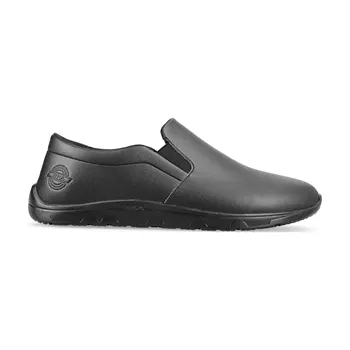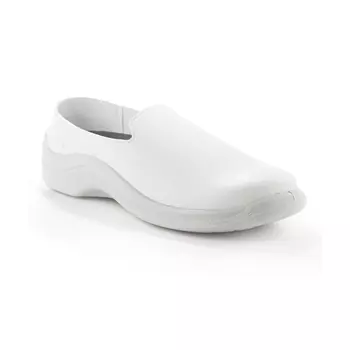
Tips for choosing chef shoes
Do you know how to choose the best shoes for the kitchen? As a chef, caterer, or other kitchen staff, you're on your feet for most of the workday, so selecting the right footwear is essential. Your chef shoes should be comfortable to wear and ensure that you don't strain your legs or back. At the same time, they should protect you from slips, falls, and accidents in the workplace. Here are some key reasons why safety shoes are crucial for the kitchen.
Prevent falls with slip-resistant shoes for the kitchen
Most kitchen shoes have slip-resistant properties. This is because the floor in an industrial kitchen or cafeteria can easily become slippery due to spills of water, oil, or other substances. To reduce the risk of slips and falls in the kitchen, look for shoes labeled with SRA, SRB, or SRC.
- SRA means that the outsole has been tested for slip resistance on a ceramic tile with soap solution
- SRB means that the outsole has been tested for slip resistance on a steel plate with glycerin
- SRC means that the outsole has passed both test A and test B
When shopping for chef shoes at Pro-dress, you can use the filters to view shoes with SRA, SRB, or SRC ratings.
Choose anti-static chef shoes with shock absorption
Standing or walking on a hard kitchen floor for hours can lead to leg or back strain. To reduce this risk, opt for work shoes with shock absorption. This feature helps protect you from repeated impacts on your heels, which could cause back and leg pain over time. Additionally, consider anti-static shoes if you work in a kitchen with sensitive electronics or other equipment that can be affected by static electricity.
Work shoes are certified in accordance with the European standard EN ISO 20347 and are divided into the following categories:
- OB: The footwear has been tested for slip resistance
- O1: The footwear has been tested for slip resistance, features an antistatic sole, and has a shock-absorbing heel
- O2: The footwear has been tested for slip resistance, features an antistatic sole, has a shock-absorbing heel, and is water-repellent (at least 80 minutes without water ingress)

Non-slip kitchen shoes

Shock-absorbent chef shoes

Water-repellent kitchen shoes
Switch between multiple pairs of shoes
After a long day at work, your chef shoes are likely damp from sweat. If they don't dry completely before you use them again, the moisture provides a breeding ground for bacteria. This can result in smelly shoes and shorten their lifespan.
It's recommended to have two or more pairs of work shoes to rotate between, allowing each pair to dry fully before you wear them again.
Chef shoes in leather or other materials
Some chefs prefer leather shoes because leather lets the feet breathe. Others opt for non-leather chef shoes that can be machine-washed. At Pro-dress, you’ll find a wide range of kitchen shoes made of leather and other materials.
Suggested footwear for chefs and caterers







Do you neep help?
If you have questions or are unsure about anything, you are always welcome to contact our customer service.




























